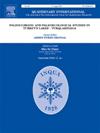电子自旋共振(ESR)测定印度上siwalik地区Pinjor组哺乳动物化石的年代
IF 1.8
3区 地球科学
Q3 GEOGRAPHY, PHYSICAL
引用次数: 0
摘要
上siwalik的Pinjor组是印度次大陆北部最广泛和连续的早更新世至中更新世矿床之一,并产生了丰富的哺乳动物化石遗骸记录。然而,它的年代学控制不佳,整个矿床的年代学限制在2.58-0.63 Ma之间。这种缺乏时间限制的情况阻碍了对平托尔时代动物群的各种分析,特别是那些侧重于了解更新世生态和气候的变化和波动及其对该地区动物群和人类种群的可能影响的分析。考虑到Pinjor组沉积物的古老,由于时间和沉积的限制,大多数绝对定年的方法已被证明在得出任何结果时都是不确定的。本文利用电子自旋共振(ESR)测年技术,对已知地层关联的牙齿化石进行了测年,并提出了将平焦时代化石位置初步划分为2.58 ~ 1.77 Ma、1.8 ~ 1 Ma和0.9 ~ 0.4 Ma三个时间区间的方法。这种方法在未来有应用的空间,特别是在印度的化石地点,有离地组合,暴露在远离古地磁年代的部分,目前受时间限制不佳。本文章由计算机程序翻译,如有差异,请以英文原文为准。
Electron Spin Resonance (ESR) dating of fossil mammals from the Pinjor Formation, Upper Siwaliks, India
The Pinjor Formation of the Upper Siwaliks, is one of the most extensive and continuous Early-to-Middle Pleistocene deposits in the northern Indian Subcontinent and has yielded rich record of fossilised mammalian remains. However, it suffers from poor chronological controls with the entire deposit chronologically constrained between 2.58-0.63 Ma using palaeomagnetic dating. Such poor temporal constraints have hindered various analyses of Pinjor age fauna, particularly those focused on understanding Pleistocene changes and fluctuations in the ecology and climate and its possible impact on faunal and hominin populations in the region. Given the antiquity of the sediments of the Pinjor Formation, most methods of absolute dating have proven to be inconclusive in yielding any results generally due to temporal and sedimentary constraints. In this paper we use Electron Spin Resonance (ESR) dating to derive chronometric dates from fossilised teeth with a known stratigraphic association and propose a preliminary division of Pinjor age fossil localities into three time bins, 2.58–1.77 Ma, 1.8–1 Ma and 0.9–0.4 Ma. This method has scope for future applications, particularly for fossil localities in India, with ex-situ assemblages, exposed away from palaeomagnetically dated sections that suffer from poor chronological constraints at the moment.
求助全文
通过发布文献求助,成功后即可免费获取论文全文。
去求助
来源期刊

Quaternary International
地学-地球科学综合
CiteScore
5.60
自引率
4.50%
发文量
336
审稿时长
3 months
期刊介绍:
Quaternary International is the official journal of the International Union for Quaternary Research. The objectives are to publish a high quality scientific journal under the auspices of the premier Quaternary association that reflects the interdisciplinary nature of INQUA and records recent advances in Quaternary science that appeal to a wide audience.
This series will encompass all the full spectrum of the physical and natural sciences that are commonly employed in solving Quaternary problems. The policy is to publish peer refereed collected research papers from symposia, workshops and meetings sponsored by INQUA. In addition, other organizations may request publication of their collected works pertaining to the Quaternary.
 求助内容:
求助内容: 应助结果提醒方式:
应助结果提醒方式:


